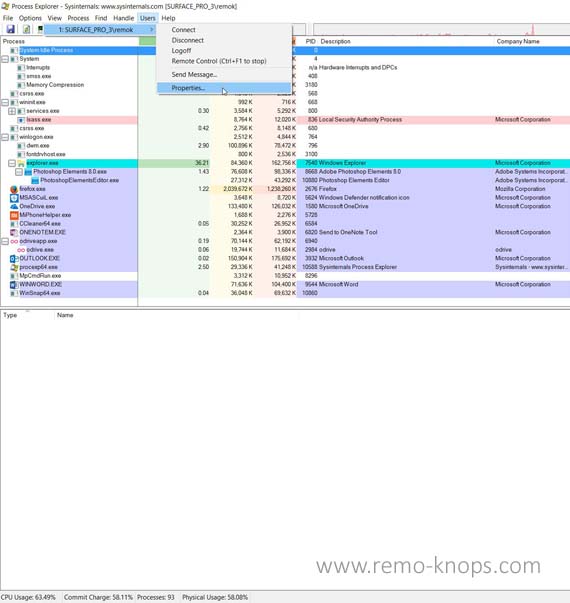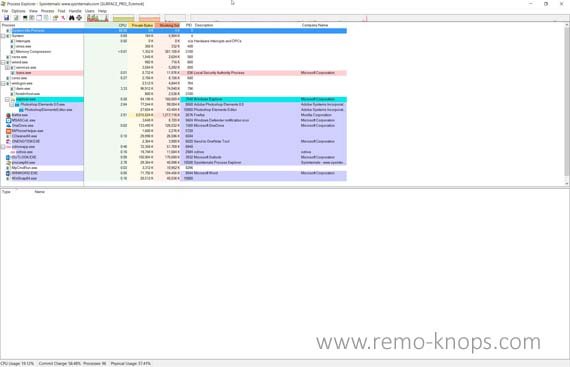

- #Windows sysinternals process explorer how to
- #Windows sysinternals process explorer install
- #Windows sysinternals process explorer update
- #Windows sysinternals process explorer windows 8.1
Among other things, you will find program entries in the Windows registry or the files opened by the program in this way. With "Ctrl+H" you can see the so-called "handles", i.e. For example, by pressing the key combination "Ctrl+D", Process Explorer shows all DLL files used by a process. The CPU history line is particularly interesting in this context.Īnother special feature is the display of the system resources used by a program. If you now sort the processes in the main window by clicking on the corresponding rows, Process Explorer lists exactly how much the processes are using your PC's CPU. Then activate the entries "CPU Usage", "CPU History", "CPU Cycles" and "CPU Time" under "Process Performance". To do this, click on “View/Select Columns”. You can perform a general performance analysis from the Process Explorer main window. Here you can read exactly how much a process influences the graphics performance. If you often work with graphics applications and would like to know how much this demands on the graphics processor in your system, the "GPU Graph" tab is of interest to you. Here you can see whether a process has swallowed up a lot of resources over time and track down performance hogs.Ĥ. The "Performance" and "Performance Graph" tabs, which you can use to view the CPU and RAM utilization of the programs, are exciting. You can use the tabs to view further information that is of particular interest to developers. Here you can see, among other things, the path to the program, you can bring it to the foreground by clicking on “Bring to Front” or close it with “Kill Process”. Simply start the program by right-clicking on it and selecting "Run as administrator".ĭouble-clicking on a process opens a detailed view. Tip: If you cannot perform certain steps below, it may be because you need to run Process Explorer with administrator rights. For example, all programs that you have opened via the start menu or the desktop are listed under the "explorer.exe" process. The programs are displayed in a nested view that shows which process opened them. Start Process ExplorerĪfter starting the program via "procexp.exe" you will see a detailed list of all the processes currently running on your Windows.
#Windows sysinternals process explorer windows 8.1
By the way, Process Explorer works from the graying Windows XP to the current one Windows 8.1 on virtually every version of the Microsoft operating system. Alternatively, you can of course also go the traditional way and the program from the Download Microsoft Homepage. You can find out how easy it is to do this with just a double-click here.

#Windows sysinternals process explorer install
New Sysinternals utility released today, Disk2vhd v1.Before you get started, you should install the latest version of the SysInternals Suite and thus also the Process Explorer. It’s a new Sysinternals Tool Day! RAMMap v1.0 released
#Windows sysinternals process explorer update
Sysinternals Update Day – Including new major release of Process Monitor (think PM + Network Monitoring = v2) Use the Sysinternals Utilities? The EULA bug dialog you? Then try this…Ī handy PowerShell script to keep your Sysinternals Suite up to date The latest Sysinternals utilities are just a URL away,
#Windows sysinternals process explorer how to
Hands On Learning How to Use the Sysinternals Process Monitor Utility Sysinternals 101 – “Notes from the field,” a quick intro to a few Sysinternals utilities (Process Explorer, TCPView, Process Monitor, VMMap) (via Sysinternals Site Discussion - New Video: Windows Sysinternals Primer: Process Explorer, Process Monitor and More)

If a picture is worth a thousand words, then at 30 frames a second for 75 minutes, this is worth… well… allot! Learn tips and tricks that will make you more effective with the Sysinternals utilities. This complementary tutorial session focuses primarily on the utilities, deep-diving into as many features as time will allow. Mark Russinovich's popular "Case Of The Unexplained" demonstrates some of their capabilities in advanced troubleshooting scenarios. “The Sysinternals utilities are vital tools for any computer professional on the Windows platform. TechEd Online - Windows Sysinternals Primer: Process Explorer, Process Monitor, and More


 0 kommentar(er)
0 kommentar(er)
